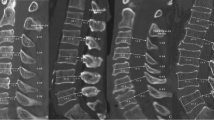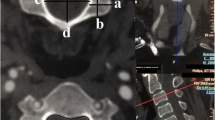Abstract
Purpose
We aimed to study generational changes in the dimensions of cervical and lumbar bony spinal canals in Western Switzerland.
Methods
A total of 254 patients were retrospectively included, 144 of whom were born during 1940–1949 and 110 during 1970–1979. Cervical spine CTs were performed as part of the spinal clearance procedure following trauma (n = 135) or while investigating neurological symptoms (CT angiography, n = 119). Three independent observers digitally measured the cross-sectional area (CSA) at pedicle levels from C0 to C7 and the anteroposterior diameter (APD) at C3, C5, and C7. In addition, lumbar spine CSAs and APDs were measured on whole body trauma or abdominal CTs, which were also available for 134 patients.
Results
Mean CSAs at pedicle levels were numerically smaller in the younger patient group in both cervical and lumbar spine, with the difference reaching statistical significance at all lumbar levels (p ≤ 0.024) except L5. Cervical APDs showed no difference between groups. Subgroup analysis revealed that younger CT angiography patients had a significantly smaller CSA at C1 (p = 0.018) and a similar trend at C4 (p = 0.053). There was moderate positive correlation between cervical and lumbar CSAs, taking C4 and L3 as reference (r = 0.509, p < 0.01).
Conclusions
Younger generation patients have smaller bony spinal canals also in the cervical spine even though this difference is less marked than at the lumbar level. There is, nevertheless, moderate positive correlation between these two anatomical regions. Perinatal factors that adversely influence spinal growth, such as increased maternal age and smoking, could explain these generational changes, given that body height has increased during the same time period. The lesser difference observed in the cervical spine could be due to later closure of the neurocentral synchondrosis at this level.




Similar content being viewed by others
References
Baron EM, Young WF (2007) Cervical spondylotic myelopathy: a brief review of its pathophysiology, clinical course, and diagnosis. Neurosurgery 60:S35–S41
Dora C, Wälchli B, Elfering A, Gal I, Weishaupt D, Boos N (2002) The significance of spinal canal dimensions in discriminating symptomatic from asymptomatic disc herniations. Eur Spine J 11:575–581
Asgari S (1996) Cervical spondylotic myelopathy. In: Palmer JD (ed) Neurosurgery’96: manual of neurosurgery. Churchill Livingstone, New York, pp 750–754
Benzel EC (1993) Cervical spondylotic myelopathy: posterior surgical approaches. In: Cooper PR (ed) Degenerative disease of the cervical spine. American Association of Neurological Surgeons, Park Ridge, pp 91–104
Ferguson RJ, Caplan LR (1985) Cervical spondylitic myelopathy. Neurol Clin 3:373–382
Arnasson O, Carlsson CA, Pellettieri L (1987) Surgical and conservative treatment of cervical spondylotic radiculopathy and myelopathy. Acta Neurochir (Wien) 84:48–53
White AA 3rd, Panjabi MM (1988) Biomechanical considerations in the surgical management of cervical spondylotic myelopathy. Spine (Phila Pa 1976) 13:856–860
Chazono M, Tanaka T, Kumagae Y, Sai T, Marumo K (2012) Ethnic differences in pedicle and bony spinal canal dimensions calculated from computed tomography of the cervical spine: a review of the English-language literature. Eur Spine J 21:1451–1458. doi:10.1007/s00586-012-2295-y
Schizas C, Schmit A, Schizas A, Becce F, Kulik G, Pierzchala K (2014) Secular changes of spinal canal dimensions in Western Switzerland: a narrowing epidemic? Spine (Phila Pa 1976) 39:1339–1344. doi:10.1097/BRS.0000000000000445
Papp T, Porter RW, Craig CE, Aspden RM, Campbell DM (1997) Significant antenatal factors in the development of lumbar spinal stenosis. Spine (Phila Pa 1976) 22:1805–1810
Jeffrey JE, Campbell DM, Golden MH, Smith FW, Porter RW (2003) Antenatal factors in the development of the lumbar vertebral canal: a magnetic resonance imaging study. Spine (Phila Pa 1976) 28:1418–1423
Eisenstein S (1977) The morphometry and pathological anatomy of the lumbar spine in South African negroes and caucasoids with specific reference to spinal stenosis. J Bone Joint Surg Br 59:173–180
Tatarek NE (2005) Variation in the human cervical neural canal. Spine J 5:623–631
Kato F, Yukawa Y, Suda K, Yamagata M, Ueta T (2012) Normal morphology, age-related changes and abnormal findings of the cervical spine. Part II: Magnetic resonance imaging of over 1200 asymptomatic subjects. Eur Spine J 21:1499–1507
Yukawa Y, Kato F, Suda K, Yamagata M, Ueta T (2012) Age-related changes in osseous anatomy, alignment, and range of motion of the cervical spine. Part I: Radiographic data from over 1200 asymptomatic subjects. Eur Spine J 21:1492–1498. doi:10.1007/s00586-012-2167-5
Battié MC, Ortega-Alonso A, Niemelainen R, Gill K, Levalahti E, Videman T, Kaprio J (2014) Lumbar spinal stenosis is a highly genetic condition partly mediated by disc degeneration. Arthritis Rheumatol 66:3505–3510
Weiler C, Schietzsch M, Kirchner T, Nerlich AG, Boos N, Wuertz K (2012) Age-related changes in human cervical, thoracal and lumbar intervertebral disc exhibit a strong intra-individual correlation. Eur Spine J 21(Suppl 6):S810–S818. doi:10.1007/s00586-011-1922-3
Teraguchi M, Yoshimura N, Hashizume H, Muraki S, Yamada H, Minamide A, Oka H, Ishimoto Y, Nagata K, Kagotani R, Takiguchi N, Akune T, Kawaguchi H, Nakamura K, Yoshida M (2014) Prevalence and distribution of intervertebral disc degeneration over the entire spine in a population-based cohort: the Wakayama Spine Study. Osteoarthr Cartil 22:104–110. doi:10.1016/j.joca.2013.10.019
Katz JN, Harris MB (2008) Clinical practice. Lumbar spinal stenosis. N Engl J Med 358:818–825. doi:10.1056/NEJMcp0708097
Dimeglio A (1993) Growth of the spine before age 5 years. J Pediatr Orthop B 1:102–107
Rajwani T, Bhargava R, Moreau M, Mahood J, Raso VJ, Jiang H, Bagnall KM (2002) MRI characteristics of the neurocentral synchondrosis. Pediatr Radiol 32:811–816
Rowland LP (1992) Surgical treatment of cervical spondylotic myelopathy: time for a controlled trial. Neurology 42:5–13
Lee MJ, Cassinelli EH, Riew KD (2007) Prevalence of cervical spine stenosis. Anatomic study in cadavers. J Bone Joint Surg Am 89:376–380
Ulbrich EJ, Schraner C, Boesch C, Hodler J, Busato A, Anderson SE, Eigenheer S, Zimmermann H, Sturzenegger M (2014) Normative MR cervical spinal canal dimensions. Radiology 271:172–182. doi:10.1148/radiol.13120370
Goto S, Umehara J, Aizawa T, Kokubun S (2010) Comparison of cervical spinal canal diameter between younger and elder generations of Japanese. J Orthop Sci 15:97–103. doi:10.1007/s00776-009-1427-7
Acknowledgments
None.
Author information
Authors and Affiliations
Corresponding author
Ethics declarations
Conflict of interest
None declared.
Additional information
F. Becce and C. Schizas contributed equally to this work.
Rights and permissions
About this article
Cite this article
Monier, A., Omoumi, P., Schizas, S. et al. Dimensional changes of cervical and lumbar bony spinal canals in one generation in Western Switzerland: a computed tomography study. Eur Spine J 26, 345–352 (2017). https://doi.org/10.1007/s00586-016-4386-7
Received:
Revised:
Accepted:
Published:
Issue Date:
DOI: https://doi.org/10.1007/s00586-016-4386-7




